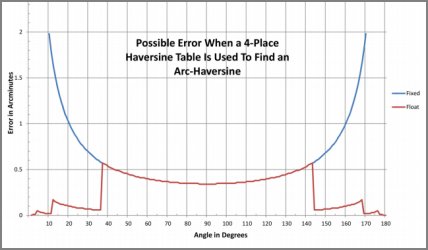
NavList:
A Community Devoted to the Preservation and Practice of Celestial Navigation and Other Methods of Traditional Wayfinding
From: Frank Reed
Date: 2018 Dec 22, 07:26 -0800
Nice graphic, Roger.
The shape of the graph should look familiar. That U-shaped curve is, of course, cosecant(x), which is another name for 1/sin(x). That makes perfect sense since the graph represents the change in the angle, x, for a given small change in the value of the "haversine(x)". The haversine is a simple variant of cos(x). Actually the haversine of any angle is (1-cos(x))/2, but its variability --everything that counts-- is directly proportional to cos(x).
Next do a tiny bit of calculus. The derivative of cos(x) is -sin(x), so then d(hav(x))/dx = sin(x)/2. And the inverse of that is 2/sin(x) --a curve proportional to cosecant(x), exactly as graphed, up to a constant of proportionality which is the result of asking for the result in minutes of arc for a change in the function at the fourth decimal place. and when you go from four-digit to five-digit, naturally the curve is reduced by a factor of ten, right?
Frank Reed
Original graphic, from Roger Sinnott's message:







